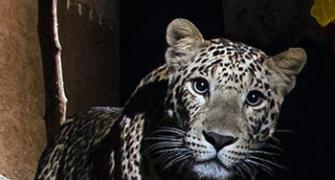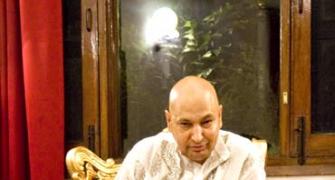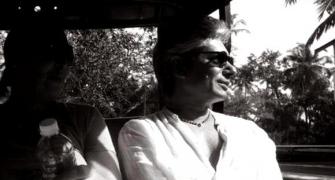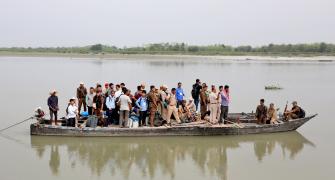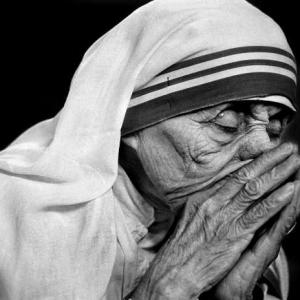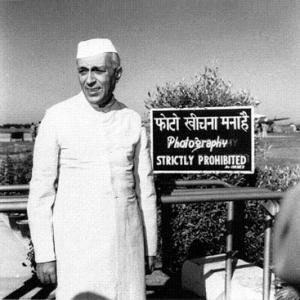Photographer S Paul, who died this month, was furiously protective about his independence and intensely sure about his work.
So much so that he once walked away from a shoot with a prime minister.
Avantika Bhuyan pays tribute.
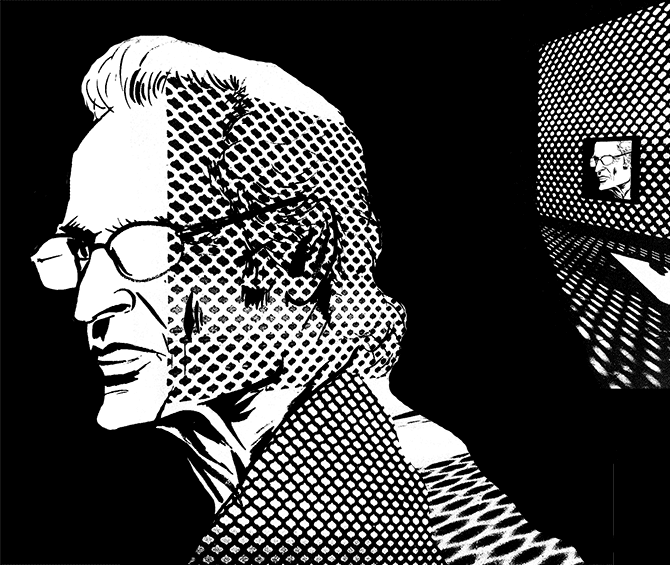
There is a particular photograph by S Paul in which a group of women is seen praying during Muharram.
The black-and-white image has a rare performative element about it, especially in the way it portrays the emotions swirling within each woman.
Another one is a haunting photograph of two women on their way to work, walking through mist, lunchboxes on their heads.
Both these photographs, like hundreds of others that Paul clicked during his lifetime, capture a slice of life and a moment in time the way few photographers before him did.
Paul, who died on August 16, three days short of 87, had the eye that could bring out magic in the mundane through intense pictures that he chose to keep largely devoid of colour.
Black-and-white was his medium.
The man who practically lived with the camera hanging around his neck drew world attention early in life.
He was the first Indian to be profiled by The British Journal of Photography in 1967, and in 2004, the B&W Magazine US nicknamed him the 'Henri Cartier-Bresson of India'. (French humanist photographer Cartier-Bresson was considered a master of candid photography.)
However, his greatest achievement was that through his work he taught generations of photojournalists to think beyond the mundane ribbon-cutting events and typical landscape shots that were a staple back then.
"As the chief photographer of The Statesman, he took some fabulous sports images -- full of humour. He would think of angles that had not been envisioned before," recalls Raghu Rai, Paul's younger brother and a celebrated photographer.
"He then became the chief photographer for The Indian Express, and during his tenure there, shot some amazing political images."
But there was also one that he didn't shoot.
In his 2014 essay in Open on the understated photographer, who was furiously protective about his independence and intensely sure about his work, photographer Ritesh Uttamchandani recalls a particular incident when Paul was photographing Morarji Desai, who was then prime minister.
Paul requested the prime minister to move a little to the left into the light. But Desai refused and told Paul to shoot him where he was and not to waste more film.
'Paul packed up and left immediately. When questioned by his editors on the absence of a photograph, he said, "The PM is saying I am wasting film, so I didn't waste any",' writes Uttamchandani.
Uttamchandani also recalls Paul's images from the 1965 war with Pakistan, when he deserted the convoy of journalists to create his own set of pictures that weren't sieved by the defence department.
During an extensive interview with Uttamchandani at his Ghaziabad residence, Paul also talked about his memorable photograph of the Republic Day parade.
To get this shot, Paul literally pushed himself to the edge, climbing up India Gate to get the picture he had in mind.
While his camera did the talking and tirelessly engaged with the world, Paul himself was a man of few words -- even a recluse, one might say.
Uttamchandani says he sought him out for a "selfish" reason.
"I was seeking a mentor-like figure," he says. "Paul was one of the most unpublished photographers in India. But the connection of his eyes and photographic faculties with his art was very sharp."
If there is one word to describe his images, it is "instinctive" -- a quality lacking in today's formulaic world."
"Everyone is trying to cater to an audience. But in his case, it was like 'To hell with it all. I like taking pictures and will shoot the way that comes to me naturally'," says Uttamchandani.
The closest comparison that comes to mind is, perhaps, of a child who laughs freely without caring if anyone's watching, he adds.
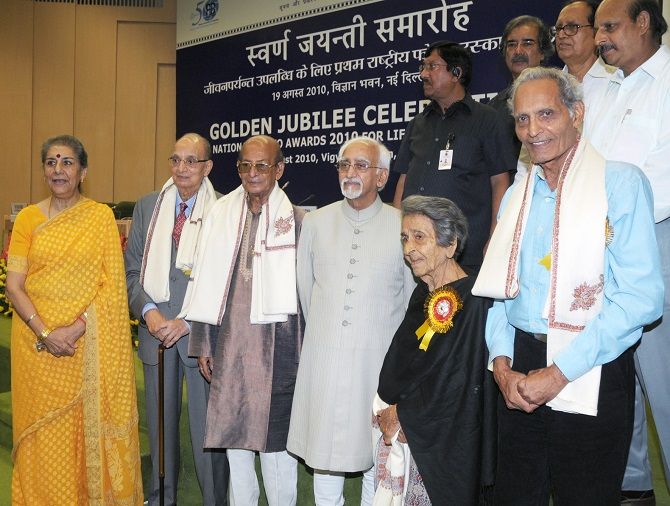
Also at the event was then vice president Hamid Ansari, front row, third from right.
Photograph: B M Meena/Photodivision
It was Paul's instinct that drove him towards photography.
He was in his early 20s in 1951 and bored of working as a draftsman in Simla with the government's central power and water commission.
He had always wanted to take pictures, so he bought himself a camera and a film and created 12 self-portraits.
That's how it began.
Paul didn't want to travel away from Delhi, so he refused an offer from Magnum. He was a recluse and happiest at home, recalls Rai.
"It was almost as though if he would leave Delhi, his kids would become unsafe. I never understood why he never travelled abroad or even within the country. Delhi did not constitute the whole world."
The brothers disagreed on many things, but also admired each other's craft.
"He was full of praise when I did the books on Bombay and Delhi," says Rai.
"At six feet, he was one of the most handsome men I had ever seen. He wore very stylish clothes, but didn't have too many of them as his suitcases were full of cameras, films and lenses," he fondly remembers.
Paul was extremely fond of classical music, poetry and sher-o-shayari and had strong opinions about these interests.
Rai says he would get very angry if someone didn't like the music that he appreciated.
Keen students of photography have always been hopelessly divided in their opinion about Paul and Rai.
Parthiv Shah, who was a student at the National Institute of Design, Ahmedabad, some three decades ago, remembers people discussing the duo vociferously like they would Satyajit Ray and Ritwik Ghatak.
"Paul's images were really hard to come by back then. I saw a little more of his work when I moved to Delhi," he says.
Shah feels dismayed that not much has been seen of works by stalwarts such as Paul and Jagan Mehta, who travelled with Mahatma Gandhi.
"The artist should just be able to focus on his craft. It is the cultural institutions that should do the job of showcasing his work. Is the comparison with his brother his only way to recognition?" Shah asks.
Despite rumours of differences between the brothers, Rai has always maintained that the two legends -- Paul and Kishor Parekh -- deeply inspired his formative years.
It was the early 1960s and Rai, a civil engineer, was bored of his temporary job with the Indian Army.
"I came to stay with Paul in 1963-64. Whenever he and his friends would hang out, they would discuss lens and camera endlessly and I would think, 'What a crazy lot'," says Rai, who, too, got caught by the photography bug two years later.
During a trip to Rohtak with Paul's friend Yogjoy, Rai ended up taking lots of photographs of donkeys standing in the corner.
"When the film was processed, and I showed it to Paul, he was full of praise. He sent my photo to The Sunday Times, London, which used to carry half-page photos on the weekend. And, it got published in my name," he says.
Uttamchandani prefers to call Paul a craftsman instead of a photographer.
"His photos are so simple and open to interpretation. He believed that the simpler the photograph, the more difficult it was to create as it asked so much of the viewer."
A same picture of Paul would speak to a person differently at different stages of life. "That," says Uttamchandani, "is the beauty of his work."


